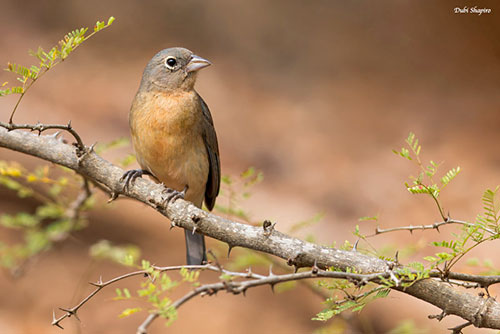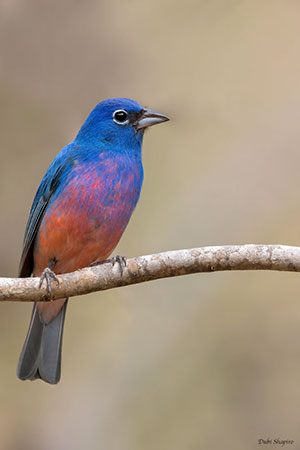
Fr: Passerin à ventre rose
Ang: Rose-bellied Bunting
All: Rosenbauchfink
Esp: Azulillo Ventrirrosado
Ita: Zigolo panciarosa
Nd: Rozebuikgors
Sd: rositafink
Photographer:
Dubi Shapiro
Dubi Shapiro Photo Galleries
Illustration:
John Gerrard Keulemans (1842-1912)
Source of the illustration: Biologia Centrali-Americana
Text by Nicole Bouglouan
Sources:
HANDBOOK OF THE BIRDS OF THE WORLD Vol 16 by Josep del Hoyo- Andrew Elliot-David Christie – Lynx Edicions – ISBN: 9788496553781
FIELD GUIDE TO THE BIRDS OF NORTH AMERICA - National Geographic Society - ISBN: 0792274512
The Wilson Journal of Ornithology
CREAGUS@Monterey Bay (Don Roberson)
Fatbirder - The World’s Richest Information Resource about Birds for Birders
Wikipedia, the free encyclopaedia
Wikipedia, la enciclopedia libre
Rose-bellied Bunting
Passerina rositae
Passeriformes Order – Cardinalidae Family
INTRODUCTION:
The species of the family Cardinalidae are robust birds with strong bills, associated with open woodlands and interior forest.
The Rose-bellied Bunting is endemic to a micro-region on the Pacific Slope of SW Mexico, where it frequents moist/semi-arid woodlands between 180 and 800 metres of elevation. It feeds on seeds from grasses, fruits from trees and bushes, and insects. The cup-shaped nest is built in the fork of a small tree, between 30 centimetres and 2,5 metres from the ground.
The Rose-bellied Bunting has restricted range in which it is affected by habitat degradation. The species is currently considered Near Threatened.

DESCRIPTION OF THE BIRD:
Biometrics:
Length: 13-14 cm
Weight: 19-20 g
The Rose-bellied Bunting adult male has bright blue upperparts and shoulders, brightest on lower back and rump. On the wings, the greyish-black primaries and secondaries have blue edges. The closed wings show blue appearance overall. On the tail, the rectrices are bright blue with black shafts.
On the underparts, throat, breast and flanks are blue. The reddish-pink mottling of the lower breast becomes mostly salmon-pink on belly and vent.
On the bright blue head, the crown is mostly tinged purplish-blue. The lores are blackish. The eye is surrounded by two white crescents forming a broken whitish eyering. The chin is greyish-white.
The strong, pointed bill is black above, but the lower mandible is pale greyish-blue. The eyes are dark brown. Legs and feet are grey.
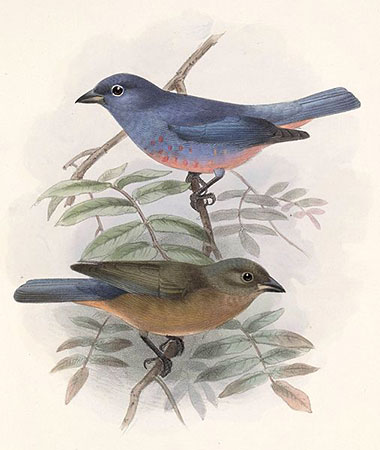
Pair
John Gerrard Keulemans (1842-1912)
The adult female is very different. Head and upperparts are greyish-brown, with sometimes some bluish wash. Rump and uppertail-coverts are bluish. On the wings, the feathers are dull brown with weak, dull brown edging. On the tail, the rectrices are grey with bluish outer webs.
The underparts are vinaceous, sometimes buffy-brown or pinkish-buff, becoming darker on throat to lower breast and flanks, and paler on lower belly.
On the head, the face is grey-brown and the broken pale greyish eyering is visible.
Bill, eyes, legs and feet are similar to the male.
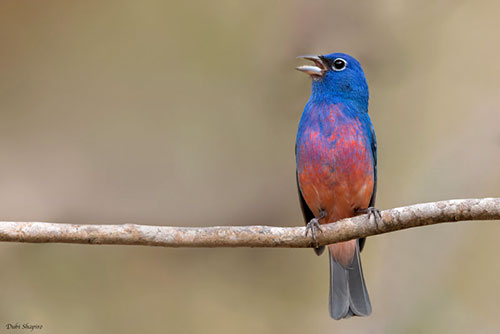
CALLS AND SONGS: SOUNDS BY XENO-CANTO
The call of the Rose-bellied Bunting is a wet “plik” or “plek”.
The song is a sweet warbler.
BEHAVIOUR IN THE WILD:
The Rose-bellied Bunting is omnivore. It feeds on plant material such as fruits, seeds and occasionally nectar from flowers. Insects are also part of the diet.
The Rose-bellied Bunting uses ravines with tropical semi-deciduous forests and hillsides with tropical deciduous forests during the breeding season.
The cup-shaped nest is built on a branch bifurcation of small sapling, about 1,2 metre from the ground, but also up to 2,5 metres.
From some observations, several nests (up to 14), were found in very similar conditions. They were placed between 10 and 60 metres from each other.
Depending on the nesting site, the nests were built on different plant species, from small bushes of 30 centimetres tall, to large trees of up to 15 metres tall.
The nests were mainly made with tree bark, twigs and spider webs.
More information is needed concerning the breeding behaviour of this species.
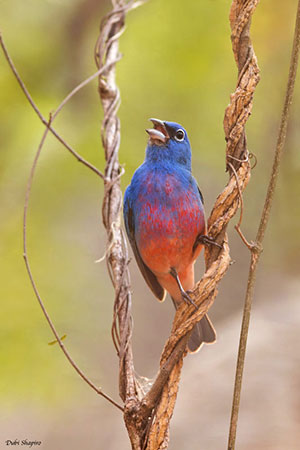
The Rose-bellied Bunting is largely sedentary, with probably some movements related to food resources.
The flight of the Cardinalidae species is usually strong and sometimes undulating. The birds fly or hop from branch to branch in bushes and trees. When on the ground, they hop rather than walk.
REPRODUCTION OF THIS SPECIES:
The breeding season probably takes place through June-July, with nests found active at end of June and end of July, and more generally from May to August.
The nest is an open cup made with tree bark, thin twigs and spider webs, the latter being sometimes used to attach the nest to the plant support. Inside, very thin twigs are interlaced and form a circular pattern.
The external diameter was 120-125 mm, the external height was 120mm and the internal depth was 50 mm.
On another nest, snake skin and feathers were used to build the external part of the structure.
The nest is often built in fork of small tree, between 1,2 and 2,5 above the ground.
The female lays 2-4 white eggs with reddish-brown spots at the larger end.
From observation of the first nest, there were 4 eggs, and the chicks fledged successfully 22 days later.
Both parents were observed vocalizing in the proximity.
No other information.
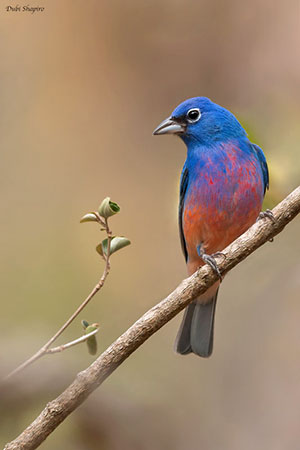
PROTECTION / THREATS / STATUS:
The Rose-bellied Bunting has restricted range in which it is threatened by fragmentation and degradation of the habitat, caused by the establishment of thousands of wind turbines. Many forests are now degraded.
Recent studies suggest the Rose-bellied Bunting prefers to breed in preserved habitat. This species is also vulnerable to the side-effect of the hurricanes in this region.
The population is estimated to number less than 50,000 mature individuals. This population is suspected to be stable, despite the threats related to the habitat. However, some decline was reported in 2016 (NABCI 2016).
The Rose-bellied Bunting is currently listed as Near Threatened.
The Sierra Tolistoque is very important for the long-term conservation of this species, and this area needs to be protected, in order to provide a future stronghold for the conservation of this so nice bird.
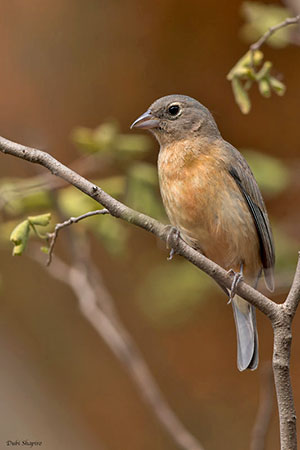
The immature male resembles female but the underparts are brighter, with rose-pink on belly. Head, breast and upperparts are flecked blue.
On the head, the crown is dull grey-black and the whitish broken eyering is well visible. The chin is whitish.
The immature female is duller than the adult female. Rump and uppertail-coverts are only faintly tinged blue. The underparts are dusky buff, with sometimes dark streaks on body sides and flanks.
RANGE:
The Rose-bellied Bunting is found in a narrow strip along the Pacific Slope of Isthmus of Tehuantepec in W Oaxaca and W Chiapas.
An additional record was recently reported further E in Chiapas, in El Triunfo Biosphere Reserve (S Mexico).
HABITAT:
The Rose-bellied Bunting frequents both arid and semi-arid thorn forest, semi-humid deciduous gallery woodland and edge and hilly areas, from 180 to 800 metres of elevation.
From several observations, this species may use ravines as nesting sites.
It can be seen in pairs or solitary at low to mid-level in brush.
